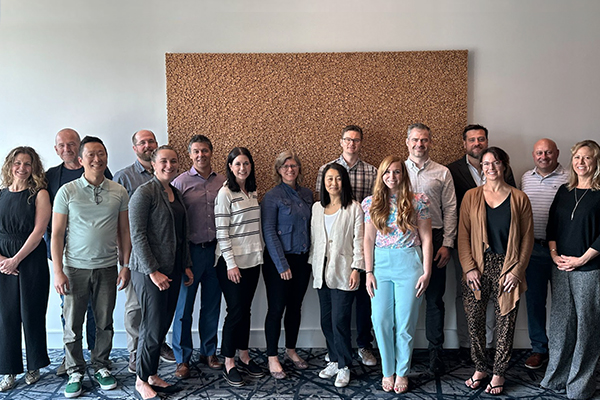HIGHLIGHTS
Program Updates
Design and Construction Pros Seek Light-Frame Education and Resources From WoodWorks
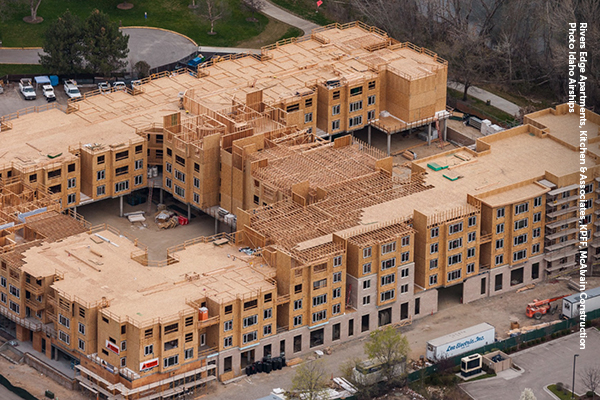
Light-frame wood construction is one of the most economical ways to build a mid-rise project, and WoodWorks helps teams maximize the value proposition while achieving quality, code-compliant buildings. Through a combination of education, technical resources, and project support, WoodWorks gives teams the knowledge and confidence to pursue projects that expand on their experience.
WoodWorks devoted its last three monthly webinars to topics that are critical to larger and taller light-frame projects: framing and unit layout efficiency, engineering approaches to exterior walls, and high-performance envelopes. The series drew 6,240 design and construction professionals, whose comments were overwhelmingly positive:
- “I normally don’t design with wood materials but will be looking for opportunities to use what I learned today.” – Engineer
- “We look to WoodWorks for guidance as we navigate the ever-changing code and construction standards. I appreciate the time and dedication to education.” – Architect
- “All WoodWorks webinars are worthwhile. The content presented is always useful, and our firm has archived many of your presentations for reference while designing projects.” – Architect
Light-frame technical resources are also among the most popular. Of the 20 most-viewed expert tip articles on the WoodWorks website, 70% focus on light-frame topics, and these articles were viewed more than 96,000 times in the past year. In Q2, 67% of the projects reported by WoodWorks (supported projects that went to construction) were light-frame wood, and 9% were light-frame/mass timber hybrids.
Think Wood Highlights Office Projects That Stand Out With Wood
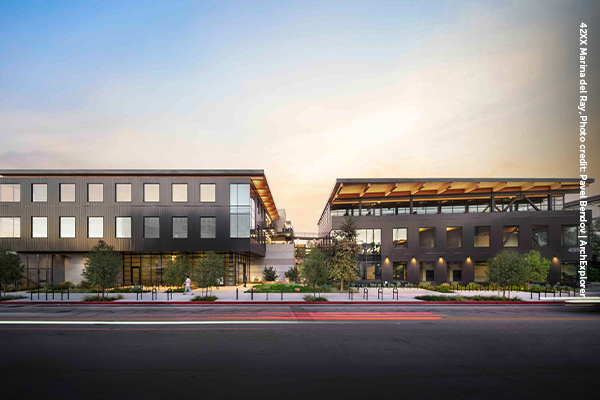
A recent Think Wood case study profiled 42XX, an innovative and creative mass timber-steel hybrid office project in Los Angeles. Mass timber’s ability to create highly desirable, biophilic office environments that stand out to prospective tenants is one of the material’s most appealing features, and the case study shows how architects at RIOS used those benefits to their advantage.
“Mass timber became central to our vision, offering sustainability, warmth, and structural efficiency,” Mark Motonaga, Creative Director and Partner at RIOS, told Think Wood. “Its tactile quality resonates deeply, creating a place that feels less corporate and more connected to its surroundings.”
Another Think Wood case study used video to provide an immersive look at Southstone Yards, a seven-story spec office building in Frisco, Texas, developed by Crow Holdings and designed by Duda|Paine and Gensler. That project used mass timber’s biophilic and sustainable appeal to land its tenant, Toyota Financial Services, which signed a lease for the entire building earlier this year. Offices and banks are an important construction segment with significant potential for growth, representing potential incremental wood volumes of 299 MM BF by increasing market share from 11% to 35%. Think Wood’s storytelling in this segment illustrates how developers and design teams can use lumber-based construction systems to differentiate their projects with clients and prospective tenants.
Faculty Workshop at Auburn Fast-Tracks Mass Timber Know-How
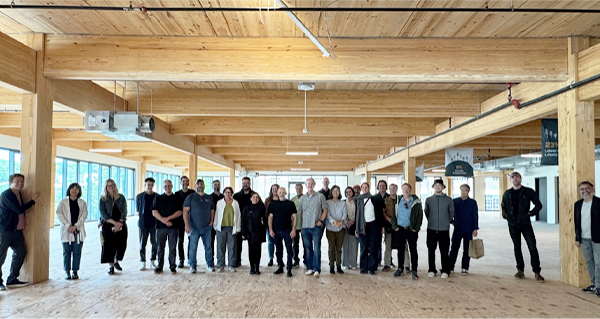
Twenty-five architecture faculty from 23 accredited university programs across 17 states gathered on Auburn University’s College of Architecture, Design & Construction campus in late May for a three-day Timber Architecture Design Faculty Development Workshop, funded by the SLB and U.S. Endowment for Forestry and Communities. The goal: fast-track mass timber expertise into U.S. architecture programs by walking professors through the entire “forest-to-frame” supply chain, arming them with the knowledge—and the confidence—to embed mass timber instruction in their design studios and technical seminars.
Led by Leers Weinzapfel Associates and Auburn’s Mass Timber Collaborative, the program blended classroom instruction with hands-on experience: sessions on sustainable forestry, mill tours at West Fraser’s Opelika sawmill, CLT production at SmartLam, and case-study walk-throughs of award-winning projects from Rural Studio’s Hale County community buildings to Atlanta’s Ponce City Market and Georgia Tech’s Living Building Challenge-certified Kendeda Building.
Rensselaer Polytechnic School of Architecture professor Adam Dayem noted that the workshop “took us from the forest to the factory to the building, giving me exactly the end-to-end understanding I need to weave mass timber into both studio and lecture.”
Attendees left with ready-to-deploy syllabus modules, a carbon-accounting playbook, and a new network of industry contacts. The return on investment will compound quickly: a post-event survey suggested 68% of the attendees were going to significantly increase mass timber-focused teaching content within the next academic year, each influencing about 81 students annually. SLB Education has completed two faculty workshops in 2025, with an additional workshop scheduled for the second half of the year.
By moving wood-focused education upstream—into the classroom before the design office or construction site—the SLB is accelerating market adoption and ensuring tomorrow’s architects can specify wood with confidence.
The AWC Releases New National Mass Timber AMM Guide
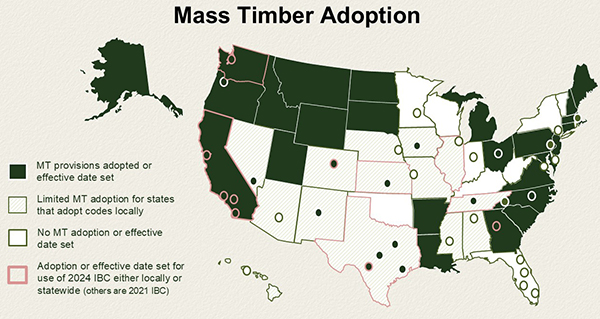
The American Wood Council is continuing its work to support mass timber code adoption by releasing a National Mass Timber Alternative Materials and Methods (AMM) Guide. The guide supports building code officials as they review and permit mass timber projects in states and jurisdictions where mass timber provisions have not yet been adopted.
Adopting new building codes based on the latest model building codes, such as the 2021 and 2024 International Building Code (IBC), can be a long and sometimes laborious process at the state and local level. States and jurisdictions are often using codes based on model building codes that are more than six years behind the most recent model building code edition. The new guide supports building code officials as they navigate mass timber when working with earlier versions of the IBC that may not include the mass timber-specific provisions. It offers the latest mass timber provisions from the 2024 IBC, which ensures the requirements for mass timber construction are accessible and accurate.
The national guide follows the AWC’s release of a Florida Mass Timber AMM Guide last year. The Florida Guide was designed specifically to be used with the eighth edition of the Florida Building Code and helps bridge the gap between the current Florida code, which does not include mass timber provisions, and the recent mass timber provisions in the 2024 IBC.
Florida building officials have already recognized the Florida Guide as a key resource for mass timber projects. With 40 states and jurisdictions now having adopted mass timber codes, the AMM guides encourage further adoption of mass timber by supporting officials’ access to and familiarity with mass timber provisions in the newer I-codes.
Spotlight
Industry Leader Highlights the SLB’s Role in Driving Demand
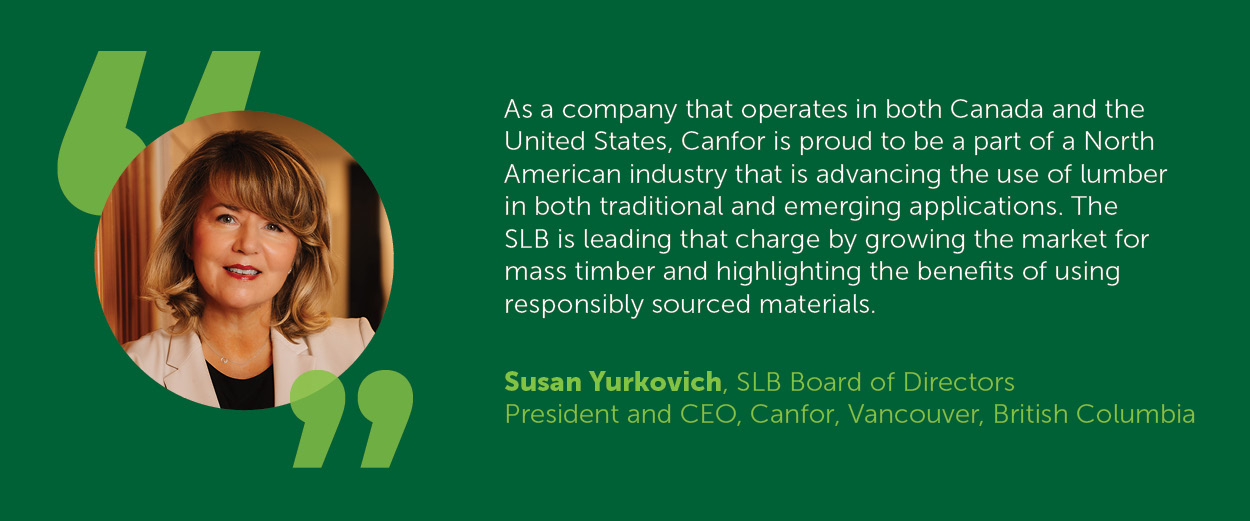
The coming years are critical to the lumber industry’s efforts to increase market share and grow demand. The lumber industry has made incredible progress on codes and standards and in the market share for wood construction—but without continuing our investment, we’ll lose the gains we’ve made.
Throughout the year, we’ll be highlighting leaders in the industry, SLB programs, and SLB partners to illustrate how and why the softwood lumber industry is working collectively to ensure we continue to grow market share. This month, SLB Director Susan Yurkovich, President and CEO of Canfor, highlights how the SLB is increasing demand for lumber in both new and traditional applications.
“At Canfor, we believe the future of building is rooted in sustainability, and lumber is central to that future,” she says. “As a company that operates in both Canada and the United States, we’re proud to be a part of a North American industry that is advancing the use of lumber in both traditional and emerging applications. The Softwood Lumber Board is leading that charge by growing the market for mass timber and highlighting the benefits of using responsibly sourced materials. Their exceptional efforts are playing a critical role in positioning lumber as a renewable, low-carbon solution while helping to drive demand for smart, sustainable construction.”
Industry Resources
FEA's Housing Dashboard
FEA’s Housing Dashboard
These housing dashboards are provided compliments of Forest Economic Advisors (FEA).
View the July Housing Dashboard
Virginia Tech's Monthly Housing Report
This monthly housing commentary report is a free service of Virginia Tech and is intended to help one gauge future business activity in the U.S. housing market.
May 2025 Reports (released in July 2025)
Part A: May Housing Commentary
Part B: May Economic Conditions


